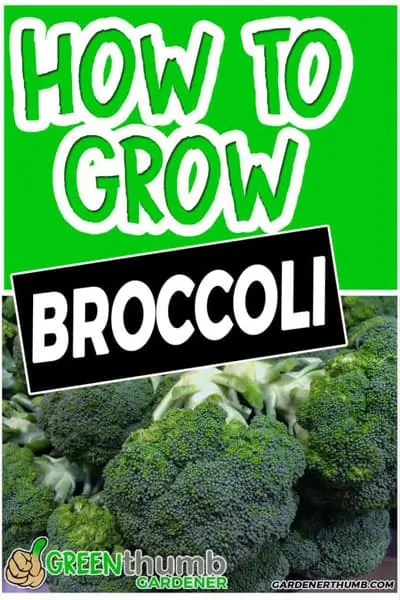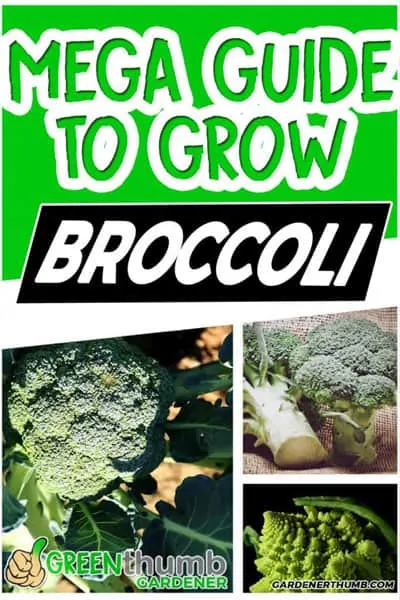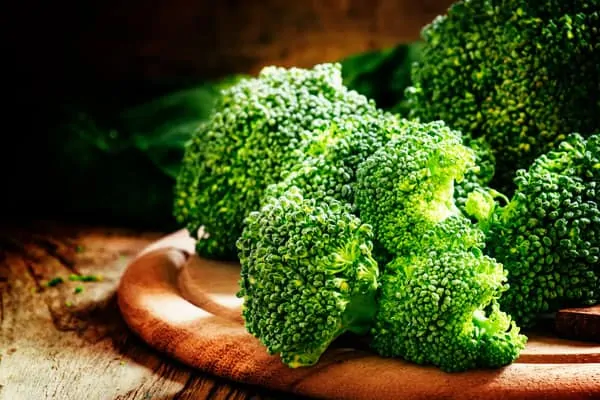Growing Broccoli From Seed to Stir Fry
Last updated: 10/14/18
Broccoli is one of those vegetables that always seems to stick out in stir-frys. You can’t miss those big chunks of dark green florets that are steaming hot on your plate of some Asian dish.
Have you ever tasted your own freshly picked broccoli from your garden? There is a huge difference between supermarket broccoli and homegrown broccoli. The fresh flavors of homegrown broccoli explode in your mouth.
You have to wonder why George Bush said, “I do not like broccoli. And I haven’t liked it since I was a little kid and my mother made me eat it. And I’m President of the United States and I’m not going to eat any more broccoli.”
It seems to be the vegetable that always gets pushed off the plate first.
I never understood why kids across America never took to the green goodness. Perhaps, because it was not prepared right. I guess my Mom did it right when she steamed it and piled it on my potato with some cheese. ok, enough talk, I am getting hunger.
Growing broccoli is very easy to do and can be grown in the spring and fall months. Broccoli seeds germinate best in soil temperatures of 60-65° F, so giving them a head start in the early spring months is best.
Broccoli grows best when spaced about a foot apart. Broccoli requires even watering throughout its growing cycle. Broccoli requires an ample amount of nutrients to mature fully. Harvesting of broccoli usually takes approximately 16 weeks from seed to table.
Green thumb Gardener occasionally links to product and/or services offered by vendors to assist you with all your gardening needs. Some of these may be affiliate links, meaning we earn a small commission if items are purchased.
Want to Download a Garden Hack Guide for FREE

Enter your email below and we will send you a guide to help you SAVE money in your garden.
Broccoli History
Broccoli (Brassica oleracea) has been cultivated since the 6th century BC. It was a favorite dish in many Italian homes during the Roman Empire.
The Italica variety was thought to have been formed from a European wild cabbage in the Eastern Mediterranean area. Early versions of broccoli were known as Italian asparagus.
It was more popularized in Italy during the 17th century. It was thought to have landed in America during the 1800s from Italian immigrants.
It has been the last thing eaten by kids at most dinner tables ever since. Fortunately, my little girls can’t get enough of it.
Growing Broccoli for Cancer Prevention
Growing broccoli is one of the foods that has immense health benefits. One recommendation to make certain you get some of these benefits below is to not boil your broccoli.
Please steam, bake or stir-fry it for goodness sakes. Boiling any vegetable has been shown to decrease its nutritional benefits.
Broccoli certainly is an impressive storehouse of nutrition. Its been shown to benefit digestion, aid in the cardiovascular and immune systems, and even help with the prevention of cancer.

Let’s take a look at some the broccoli beneficial facts to help you keep it on your plate.
- High Fiber Content – Broccoli contains about 3 grams of fiber per 5 oz (1 medium raw stalk). It is one of those vegetables that help keep you regular if you know what I mean. High fiber is vital for digestion and for weight loss as it gives you that full feeling.
- Anti-inflammatory benefits – Broccoli contains a chemical called sulforaphane which was shown to help people who suffer from some forms of arthritis. This chemical blocks the enzyme that causes joint destruction. Broccoli a day keeps the doctors away.
- Cancer Prevention – You already know about its powerful digestion benefits. Certain chemicals that broccoli contains either delay or slow certain types of cancers. Some scientist are doing further research on the properties of this, but it is showing some promising results.
- Improves Bone Health – Broccoli contributes to your daily need for calcium, providing 43 mg in one cup. Broccoli also contains vast amounts of vitamin K. One cup of chopped broccoli provides 92 micrograms of vitamin K. Low vitamin K intake is linked with a higher risk of bone fracture. Vitamin K improves bone health by increasing the absorption of calcium and reduces urinary excretion of calcium.
Step by Step Guide on How to Grow Broccoli
Growing broccoli is a rewarding vegetable that flourishes during the spring and fall times of the year. It is recommended you start the broccoli seeds in seedling trays prior to planting in your garden or container.
Check out these 10 tips for growing broccoli in a container here.
You can get a head start while it is much colder out for the spring planting and not crowd your summer garden for a fall crop.
This guide will focus on planting broccoli from a seedling and directly into a ground garden bed or raised bed garden. Feel free to modify these steps if you plan to plant your broccoli seeds directly into your garden bed. You can also use containers for growing broccoli.
Materials Need for Planting Broccoli
- Broccoli Seeds– We highlighted some of our favorite varieties of broccoli to grow below. Make sure you check the days to harvest on your particular variety to ensure you plan the time needed
- Fertilizer or compost– Giving the broccoli a good start of nitrogen is recommended to grow successfully. It is best to start with a balanced fertilizer with an NPK ratio of at least a 10:10:10 to 14:14:14.
- Seedling trays (optional) – It is recommended to start these in a seedling tray to maximize the growth period. The summer garden gets crowded this time of year, so save some space and start the broccoli plants in seedling trays.
- Container (optional) – This guide focuses on planting directly in your garden from seedlings. However, broccoli plants do well in containers of at least 12 inch deep and at least 18 inches in diameter for most varieties of broccoli.
Steps to Grow Broccoli
1. Place 1-2 seeds in each seed tray spot. Keep seed trays moist throughout the growing cycle.
2. Thin each seedling tray to have 1 plant per seedling tray section.
3. The broccoli plants are ready to transplant anytime they are at least 6 inches and has at least 4-5 true leaves. Note: In the springtime, you also want to make sure that your daytime temperatures are at least 50°F for your area before transplanting your broccoli plants. Roughly about 4 weeks before your last frost date
4. Start by locating a space in your garden that you want to plant your broccoli in. Ideally, a place that has full to partial sun is best for broccoli.

5. Work in your compost or fertilizer into the soil prior to planting. This will promote growth for your broccoli plants because they are heavy feeders and need lots of nutrients.
6. Dig a small hole that is bigger than your potting seedling size. You can also work in a scoop of compost in the planting hole to also.
7. Plant your broccoli plant in the hole you just dug.
8. Space each plant at least 6 inches apart for smaller heads and up to 12 inches apart for larger heads spaced in rows spaced 1-2 feet apart.
9. Cover the broccoli plants with the remaining soil & water in.
10. Mulching is highly suggested for broccoli plants to help control the moisture levels
11. It is recommended to let the broccoli plants grow for 5-10 days before you add liquid fertilizer to your broccoli plants.
Where is the Best Place to Grow Broccoli
Broccoli requires full sun in order to grow into large heads. It can tolerate partial shade, but just be aware that it will extend its harvest period since growth with be minimal.
6 hours of sun is the best. It helps that there is some shade if you plant it in the summer because it does better in cooler weather.
The soil of where you plant your broccoli should be teeming with lots of organic materials. The broccoli plant is a heavy feeder, so make sure you get your soil amendments in prior to planting. See the fertilizer section below more recommendations.
Keep in mind that during the fall and spring times that the amount of sunlight is changing due to the shift of the earth. This means that the position of the sun during these times will vary.
Be mindful of the position of the sun as you plan out your garden in case you have structures or other tall crops close by.
When is the best time for Growing Broccoli
Broccoli is a biennial plant that can be planted in both the late summer & early fall and early spring times. In some parts of the country, it can be overwintered with the proper climate or some form of covering.
It definitely requires much cooler weather in order to grow broccoli successfully. This is a good thing because it also means fewer pests during colder periods.
Broccoli can be seeded directly in your garden about 30 days prior to your last spring frost date. You can also get them started indoors about 5 to 6 weeks before setting them outside if you want to get a jump on the spring.
I prefer to grow it during Fall for a spring harvest (and sometimes winter harvest if planted late summer) as it is so low maintenance. Our zone lends an advantage that allows us to overwinter our vegetables with the addition of a hoop house.
This cures the blues of winter to see healthy greens growing. We do this with quite a few of our vegetables and is easy to do once you get the hang of it. Who doesn’t like growing plants in the winter time?
Check out this book on Amazon if you are interested in growing vegetables in the dead of winter. The author Elliot Coleman grows vegetables in Northern Maine where the winters are long and cold without any fossil fuels.
Yeah, it seems impossible. Click here for the latest Amazon prices.

Further Reading
Companion Planting for Broccoli
Plants that help each other are extremely beneficial to know as a gardener. This companionship helps to repel insects and even large critters. As humans, we have played with nature in ways to compartmentalized gardening.
We need to take a step back and learn to promote nature’s balance. One way to do this is to utilize companion planting. Here are some recommendations for broccoli plants.
Good Companion Plants for Broccoli
- Dill
- Celery
- Chamomile
- Sage
- Peppermint
- Rosemary
- Potatoes
- Beets
- Onions
Bad Plants to Grow near Broccoli
- Tomatoes
- Pole Beans
- Strawberries
Caring for your Growing Broccoli
Broccoli Water Requirements
Broccoli requires about 1 to 1 1/2 inches of water per week for the spring crop. You want to keep the soil moist, but not too wet. It is also best to mulch in the area when the temperatures reach 75 degrees or higher to help retain moisture levels.
Fall crops will need a steady supply of water but no more than 1 inch per week. You don’t want the broccoli to get completely dry as it can result in tougher stems.
I love growing Broccoli during the mild winters in zone 7b under a hoop house because we almost never have to water it as the moisture levels remain constant after the initial soaking. It is amazing what a greenhouse environment does during the winter.
Broccoli Fertilizing Requirements
Broccoli requires an ample supply of nutrients to grow. It is recommended to start with a good amount of balanced compost as it requires a healthy dose of nitrogen to get started.
A good compost blend that will benefit your broccoli is vermicompost.
You can also use a good mix of aged cow manure, aged chicken manure, wood ashes, greensand, any other organic materials to prepare your area prior to planting broccoli.
You also can give it a balanced feeding of liquid fertilizer a week after it has been planted, so the organic materials have had some time to break down in the soil.
Broccoli is a heavy feeder of nitrogen, so it is also a good idea to plant a new crop as part of rotation following the legume family. Check out some other information about fertilizers in our series found here.

Pest/Diseases of Broccoli
Here are a few of the little pest that can affect your broccoli:
- Flea Beetles – These are little black beetles speckled with orange/yellow stripes. They are usually found on the underside of leaves or close to the soil.
- They jump like fleas when they are disturbed. The usually dot the leaves with mini dotted holes that can severely stress the plant if left untreated.
- Aphids – You may see these mini little green bugs that just suck the life out of the plants. Usually, they are on the underside of your plants and may also have an army of ants helping them along.
- Cabbage Loopers – These are moths and looks like a loop when it is crawling hence its name.
- Cabbageworms – These worms are very small green larvae. They have a few faint yellow stripes and will munch on the broccoli leaves and stems.
- Cabbage maggots – These maggots are white, legless, and about ⅓ inch long. Typically the form in groups and feed on the root part of the broccoli.
- Cutworms – These are actually moth larvae that come out during the dark to devour on the broccoli stems and bottom leaves
Here are a few diseases that can affect your broccoli:- Black Rot – Wet humid conditions are ripe for the black rot to develop. Affected areas turn brown and dry out, often leaving a triangular-shaped lesion on the leaf margin with one point of the triangle directed toward the midrib.
- Fusarium Wilt – The leaves turn yellow as fusarium wilt develops. Eventually, the broccoli plants start wilting and dyes. Soon after yellowing appears, the water-conducting tissue becomes reddish brown, usually first on one side of the stem.
- The disease is most common in the summer months.
- Club Root – This disease affects brassica crops in the roots of the plants. The roots become swollen and form an almost club foot that is prone to spoiling. This causes problems with the plant’s ability to absorb water and other nutrients in the soil.
Harvesting & Storing your Broccoli
Broccoli Harvest
Broccoli plants are actually flowers buds that have not bloomed yet. Knowing this should help you to know when the best time is to harvest them. You want to cut the bud cluster heads just before they bloom.
You may notice a slight yellow form on some of the buds. This is when you want to cut the heads off. I usually time is based on the days to harvest. I think the broccoli tastes much better when harvested a week earlier when the buds are nicely formed. It seems to be almost sweeter at this point.
Cutting the broccoli floret from the main stem causes other side shoots to form, so keep the broccoli planted. The energy of the plant is directed into forming side shoots that will continue to grow until the plant switches to its flowering stage.
Take advantage of this growing hack to harvest more broccoli florets.
Steps to Harvest your Broccoli
- Start to harvest your broccoli just before the florets start to open and turn yellow.
- Cut the florets just below the point where the stem branches off.
- Tender side shoots will form after the main stem is cut. You can continue to harvest these shoots until the weather is too warm or cold.
Storing your Broccoli
There are a few options for storing your broccoli plants. You can store your newly harvested broccoli florets in your refrigerator for up to about 1-2 weeks. The florets will start to spoil after 2 weeks, so its best to use them a quickly as you pick them.
The other option is to freeze the florets for later consumption. We prefer to freeze the broccoli that we know we won’t eat within 2 weeks of picking. We simply blanch the florets and freeze them for later uses in stir-frys.
Another option to store broccoli is to pickle the florets and stems. Broccoli makes for an excellent pickled vegetable. Check out some more information about preserving & storing your harvest here.

Varieties of Broccoli to Grow
Here is a list of different varieties of broccoli to grow in your garden. They are grouped into 3 main varieties of broccoli: Broccoli, Romanesco Broccoli, and Broccoli Rabe.
These types are also best for heirloom or open-pollinated plantings to ensure you can save these seeds for planting future broccoli crops.
Broccoli
Calabrese Green Sprouting Broccoli – 80 days to harvest. An Italian heirloom brought to America in the 1880s; it grows 5-8” heads and produces many side shoots.De Cicco – 55 days to harvest. Brought to the US during the 1890s from Italy. Plants grow from 18 – 30 inches highPurple Sprouting – 100 days to harvest. Very hardy during cold weather. Produces single florets.Goliath Broccoli – 75 days to harvest. It can grow to be massive in ideal conditions. Tight curds form on large heads and produce many side shoots after the main head is harvested.Waltham 29 Broccoli – 75 days to harvest. A very common type that was introduced in the 1950s. It produces 4-8” green heads that have a nice flavor and texture. A Green thumb Gardener favorite.
Romanesco Broccoli
- Romanesco Italia Broccoli – 75 days to harvest. This plant produces good yields of broccoli almost lime-green cauliflower. It is an Italian variety that a unique taste, flavor and look than other broccoli/cauliflower. It has a milder, sweeter flavor than white cauliflower.
Broccoli Rabe
Broccoli Raab, Fall – 60 days to harvest. Known as Italian turnip or turnip broccoli. It is non-heading broccoli, that is best sown in early fall for a spring crop.Broccoli Raab, Spring Sorrento – 60 days to harvest. Tasty raab with a sharp and sweet flavor.Deitrich’s Wild Broccoli Raab – A biennial broccoli that is ideal for a late Spring planting or in late Summer. Dark green broccoli raab provides a bitter green that continues to produce cut and come again
Broccoli Planting & Growing Guide
Planting & Growing Guide
Sowing Broccoli
- Planting Depth: 1/4″(6 mm)
- Soil Germination Temperature: 40-75°F (4-24°C), germinates best at around 77°F (25°C)
- Germination Period: 4-7 days
- Sow Outdoors: last spring frost date to late spring; Early summer for the fall crop
- Sow Indoors: 40-60 days before the last frost for Spring crop; start 60 -90 days before first frost date for a Fall crop
Growing Broccoli
Range of pH: 6.5-7.5Best Growing Soil Temperature: 60-65°F (16-18°C)Spacing in Beds: 12 to 15 inchesSquare Foot Spacing: 1 per squareWater Requirements: ModerateLight: Full sun is optimal for the best yield, but does tolerate partial sunlightNutrients Requirements:
- Nitrogen (N)= high;
- Phosphorus (P) = high;
- Potassium (K) = high
Seed to Harvest/Flower Period: 16 weeks








